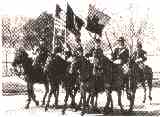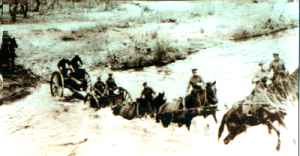
No matter what your view is about the military, it has been a necessary component of our national security. Our legacy of being able to protect ourselves and our interests is written with the courage and sacrifice of brave men and the sturdy horses which transported them, their artillery and equipment under the most difficult of conditions. While the men shared a sense of duty and purpose, the horses simply did their jobs.
During the westward expansion, cavalry posts were constructed and the cavalry was utilized to protect commerce and American settlers. While encounters and skirmishes with Native Americans are the most widely known activities of these soldiers, much time was spent policing relatively lawless territories; protecting immigration trails, rail and overland trading caravans, the movement of the mail and numerous small, rural isolated settlements. During the Civil War, most regular cavalry units were used in the eastern campaigns while many midwest and western outposts were often staffed by state militia units. World War-I demonstrated the development of a new technological advance, the tank, and by the late 1920s the Ward Department had directed that a tank force be developed and the cavalry became mechanized. In October, 1938, large scale maneuvers of both horse and machinery were held at Ft. Riley, KS, and the conclusion was clear. The age of the cavalry horse had ended and an era of heavy land machines had begun. A few horses were still maintained by individual soldiers for battle reenactments and other historical presentations. In 1992, the Commanding General's Mounted Color Guard was created at Ft. Riley, KS, whose purpose was to train and maintain a limited number of horses in the traditional cavalry style and provide a living history of the organization of men and beasts who protected our country for nearly 100 years. This unit develops its own horses and performs ceremonies and conducts reenactment missions on a regular basis.
The US Army is not one to forget it's rich history and even modern military imagery reflects reminders of its past. 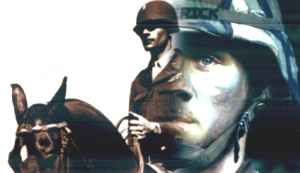
Horses of the Mounted Color GuardThe History of the Ft. Riley Wild Horse ProjectMustangs of the Mounted Color GuardReturn to KBR World of Wild Horses & BurrosGo To
|

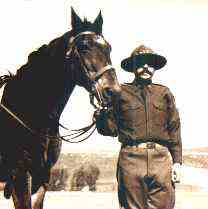 The US cavalry was successful due to a tradition of good horsemanship and cavalrymen who cared for their mounts. The cavalry was known as "the hardest branch there is in the service." Most men regarded their enlistment in the cavalry, which drew $12 a month in pay, as a serious and purposeful act.
The US cavalry was successful due to a tradition of good horsemanship and cavalrymen who cared for their mounts. The cavalry was known as "the hardest branch there is in the service." Most men regarded their enlistment in the cavalry, which drew $12 a month in pay, as a serious and purposeful act.
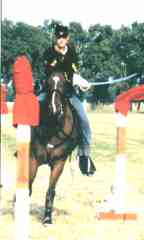 Most recently the Color Guard has begun acquiring mustangs from the Bureau of Land Management, a modern throwback to the days when horses were intentionally turned out on the plains to propagate and provide a supply of "remounts" in time of war. The mustangs were gathered from areas where their populations were approaching the limit that their environment could support, so not only is the Color Guard preserving history, but it is also helping protect America's wild horses.
Most recently the Color Guard has begun acquiring mustangs from the Bureau of Land Management, a modern throwback to the days when horses were intentionally turned out on the plains to propagate and provide a supply of "remounts" in time of war. The mustangs were gathered from areas where their populations were approaching the limit that their environment could support, so not only is the Color Guard preserving history, but it is also helping protect America's wild horses.
